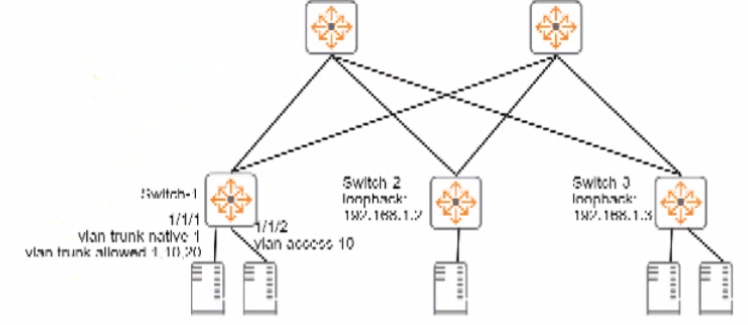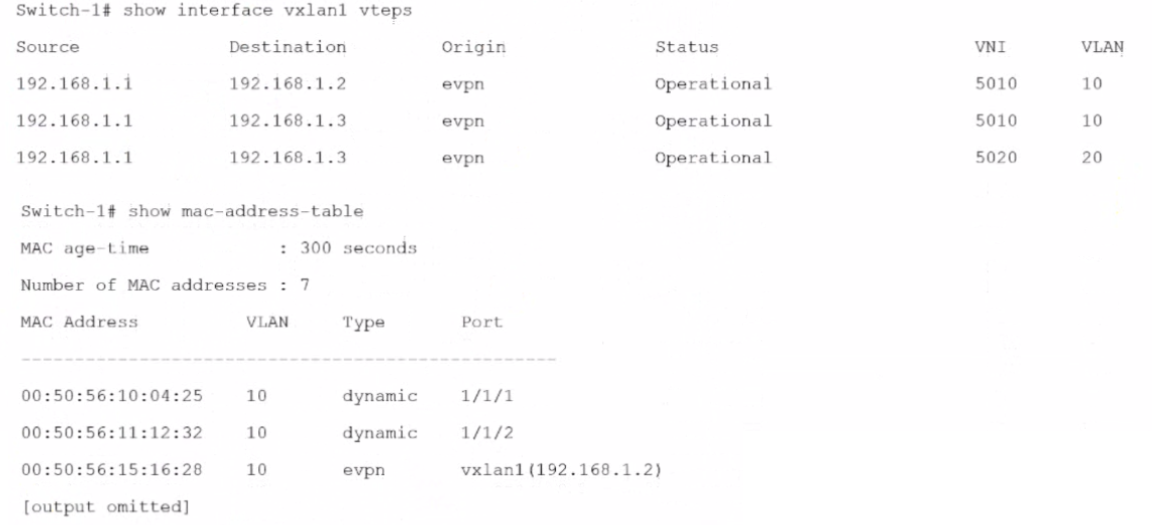HP Aruba Data Center Network Specialist HPE2-W09 Exam Practice Test
You need to integrate Aruba Fabric Composer (AFC) with customer datacenter software. Is this integration possible?
Solution: Aruba Fabric Composer (AFC) with HPE StoreServ Management Console (SSMC)
You enter this command on an ArubaOS-CX switch:
Switch# show erps status ring 1
Is this what the specified status means?
Solution: The status is Protection, which means that the ring is up and fully connected with the RPL port blocked.
Is this a use case for disabling split-recovery mode on ArubaOS-CX switches in a Virtual Switching Extension (VSX) fabric?
Solution: In situations in which the primary switch fails and then reboots, you want to make the primary switch take over again as the primary switch.
Refer to the exhibits.


Is this how the switch handles the traffic?
Solution: A broadcast arrives with a VLAN 10 tag on 1/1/1 on Switch-1. Switch 1 drops the frame.
Answer : B
Based on the exhibits, Switch-1 has a trunk port on 1/1/1 that allows VLANs 10 and 20. Switch-2 has an access port on 1/1/2 that belongs to VLAN 10. Switch-3 has an access port on 1/1/3 that belongs to VLAN 20. If a broadcast arrives with a VLAN 10 tag on 1/1/1 on Switch-1, Switch-1 does not drop the frame. Instead, Switch-1 forwards the frame to all ports that belong to VLAN 10, which includes the trunk port 1/1/2 and the access port 1/1/4. Switch-2 receives the frame on its access port 1/1/2 and forwards it to all ports in VLAN 10, which includes the access port 1/1/5. Switch-3 does not receive the frame because it is not in VLAN 10. Therefore, this is not how the switch handles the traffic, and the correct answer is no.
Is this a use case for implementing Enhanced Transmission Selection (ETS) on an ArubaOS-CX switch?
Solution: to help the switch to look inside tunneled traffic and apply different quality of service (QoS) settings to different types of traffic
Answer : B
To help the switch to look inside tunneled traffic and apply different quality of service (QoS) settings to different types of traffic is not a use case for implementing Enhanced Transmission Selection (ETS) on an ArubaOS-CX switch. ETS is a feature that provides bandwidth allocation and priority assignment for different traffic classes based on IEEE 802.1Qaz standard. ETS does not help the switch to look inside tunneled traffic, but rather relies on the priority values in the outer header of the tunneled traffic to apply QoS settings. A better way to help the switch to look inside tunneled traffic and apply different QoS settings to different types of traffic would be to use deep packet inspection (DPI) or application visibility and control (AVC) features.
Is this a way that Virtual Switching Extension (VSX) differs from Virtual Switching Framework (VSF)?
Solution: VSX permits admins to select which features to synchronize between members while VSF requires manual configuration of Identical features on each member of the VSF fabric.
Refer to the exhibits.


Is this how the switch-1 handles the traffic?
Solution: A broadcast arrives in VLAN 10 on Switch-1. Switch 1 forwards the frame on all interfaces assigned to VLAN 10, except the incoming interface. It encapsulates the broadcast with VXIAN and sends it to 192.168.1.3, out not 192.168.1.2.
Answer : B
A broadcast arrives in VLAN 10 on Switch-1. Switch 1 forwards the frame on all interfaces assigned to VLAN 10, except the incoming interface. It encapsulates the broadcast with VXLAN and sends it to 192.168.1.3, but not 192.168.1.2 is not a correct explanation of how the switch handles the traffic. Switch-1, Switch-2, and Switch-3 are ArubaOS-CX switches that use VXLAN and EVPN to provide Layer 2 extension over Layer 3 networks. VXLAN is a feature that uses UDP encapsulation to tunnel Layer 2 frames over Layer 3 networks using VNIs. EVPN is a feature that uses BGP to advertise multicast information for VXLAN networks using IMET routes. Switch-1 receives a broadcast in VLAN 10, which belongs to VNI 5010. Switch-1 forwards the frame on all interfaces assigned to VLAN 10, except the incoming interface, as per normal Layer 2 switching behavior. However, Switch-1 does not encapsulate the broadcast with VXLAN and send it only to 192.168.1.3, which is Switch-2's loopback interface, but rather replicates the broadcast, encapsulates each broadcast with VXLAN, and sends the VXLAN traffic to both 192.168.1.2 and 192.168.1.3, which are Switch-3's and Switch-2's loopback interfaces respectively.